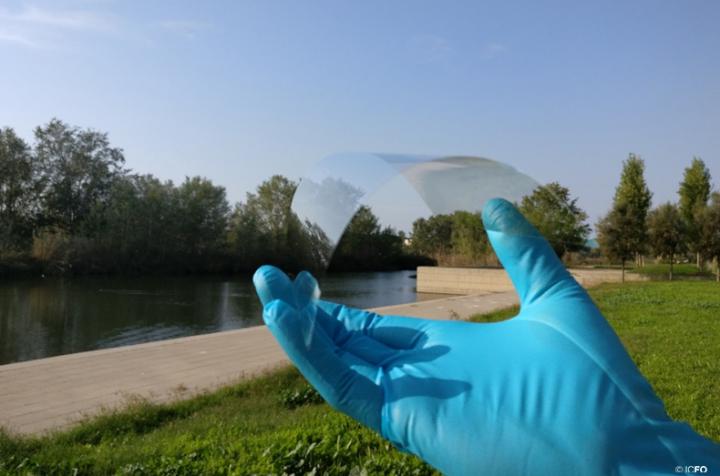An invisible electrode

Flexible Transparent Conductor is shown. Credit: ICFO
Transparent conductors are one of the key elements of today's electronic and optoelectronic devices such as displays, light emitting diodes, photovoltaic cells, smart phones, etc. Most of the current technology is based on the use of the semiconductor Indium Tin Oxide (ITO) as a transparent conducting material.
However, even though ITO presents several exceptional properties, such as a large transmission and low resistance, it still lacks mechanical flexibility, needs to be processed under high temperatures and is expensive to produce.
An intensive effort has been devoted to the search of alternative TC materials that could definitively replace ITO, especially in the search for device flexibility. While the scientific community has investigated materials such as Al-doped ZnO (AZO), carbon nanotubes, metal nanowires, ultrathin metals, conducting polymers and most recently graphene, none of these have been able to present optimal properties that would make them the candidate to replace ITO.
Today ultrathin metal films (UTMFs) have been shown to present very low resistance although their transmission is also low unless antireflection (AR) undercoat and overcoat layers are added to the structure. ICFO researchers Rinu Abraham Maniyara, Vahagn K. Mkhitaryan, Tong Lai Chen, and Dhriti Sundar Ghosh, led by ICREA Prof at ICFO Valerio Pruneri, have developed a room temperature processed multilayer transparent conductor optimizing the antireflection properties to obtain high optical transmissions and low losses, with large mechanical flexibility properties. They have published their results in a recent paper published in Nature Communications.
In their study, ICFO researchers applied an Al doped ZnO overcoat and a TiO2 undercoat layer with precise thicknesses to a highly conductive Ag ultrathin film. By using destructive interference, the researchers showed that the proposed multilayer structure could lead to an optical loss of approximately 1.6% and an optical transmission greater than 98% in the visible.
As Prof. Valerio Pruneri states, “we have used a simple design to achieve a transparent conductor with the highest performance to date and at the same time other outstanding attributes required for relevant applications in industry”. This result represents a record fourfold improvement in figure of merit over ITO and also presents superior mechanical flexibility in comparison to this material.
The results of this study show the potential that this multilayer structure could have in future technologies that aim at more efficient and flexible electronic and optoelectronic devices.
###
About ICFO
ICFO – The Institute of Photonic Sciences, member of The Barcelona Institute of Science and Technology, is a research center located in a specially designed, 14.000 m2-building situated in the Mediterranean Technology Park in the metropolitan area of Barcelona. It currently hosts 400 people, including research group leaders, post-doctoral researchers, PhD students, research engineers, and staff. ICFOnians are organized in 23 research groups working in 60 state-of-the-art research laboratories, equipped with the latest experimental facilities and supported by a range of cutting-edge facilities for nanofabrication, characterization, imaging and engineering.
The Severo Ochoa distinction awarded by the Ministry of Science and Innovation, as well as 14 ICREA Professorships, 22 European Research Council grants and 6 Fundació Cellex Barcelona Nest Fellowships, demonstrate the centre's dedication to research excellence, as does the institute's consistent appearance in top worldwide positions in international rankings. From an industrial standpoint, ICFO participates actively in the European Technological Platform Photonics21 and is also very proactive in fostering entrepreneurial activities and spin-off creation. The center participates in incubator activities and seeks to attract venture capital investment. ICFO hosts an active Corporate Liaison Program that aims at creating collaborations and links between industry and ICFO researchers. To date, ICFO has created 5 successful start-up companies.
Media Contact
All latest news from the category: Materials Sciences
Materials management deals with the research, development, manufacturing and processing of raw and industrial materials. Key aspects here are biological and medical issues, which play an increasingly important role in this field.
innovations-report offers in-depth articles related to the development and application of materials and the structure and properties of new materials.
Newest articles

NASA: Mystery of life’s handedness deepens
The mystery of why life uses molecules with specific orientations has deepened with a NASA-funded discovery that RNA — a key molecule thought to have potentially held the instructions for…

What are the effects of historic lithium mining on water quality?
Study reveals low levels of common contaminants but high levels of other elements in waters associated with an abandoned lithium mine. Lithium ore and mining waste from a historic lithium…

Quantum-inspired design boosts efficiency of heat-to-electricity conversion
Rice engineers take unconventional route to improving thermophotovoltaic systems. Researchers at Rice University have found a new way to improve a key element of thermophotovoltaic (TPV) systems, which convert heat…



